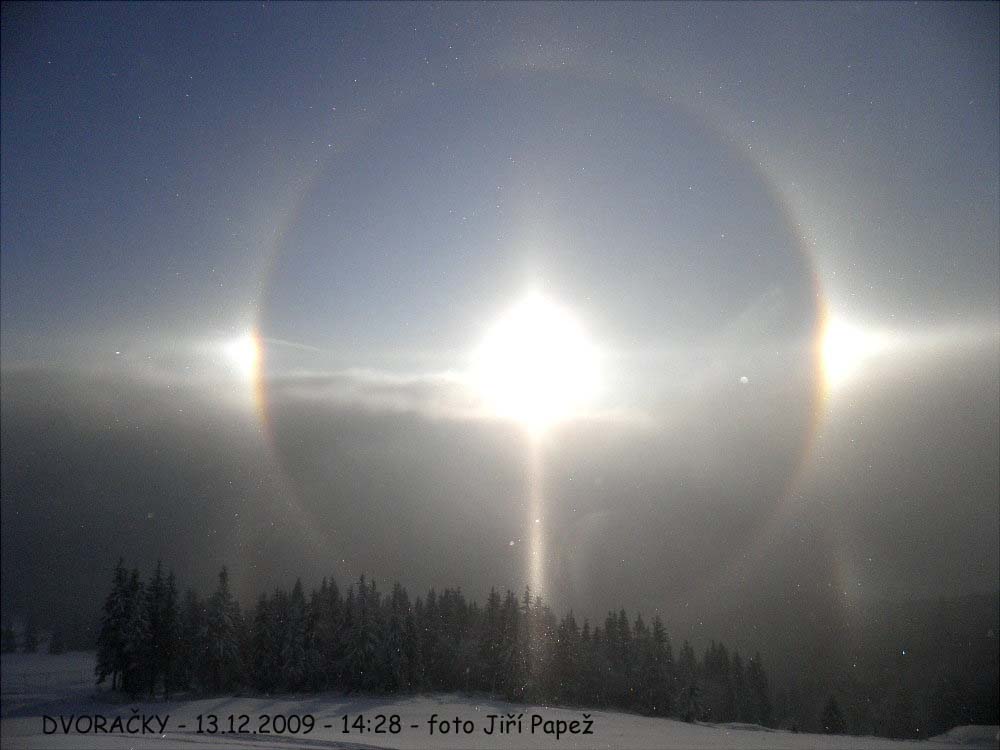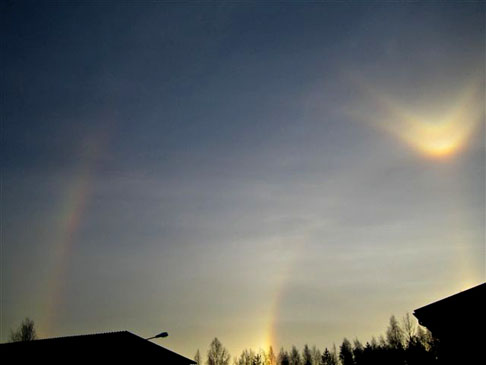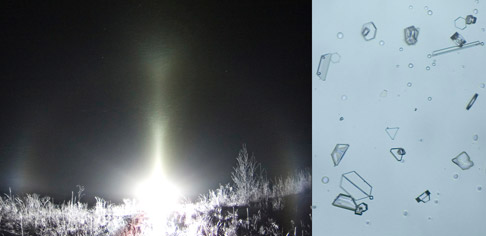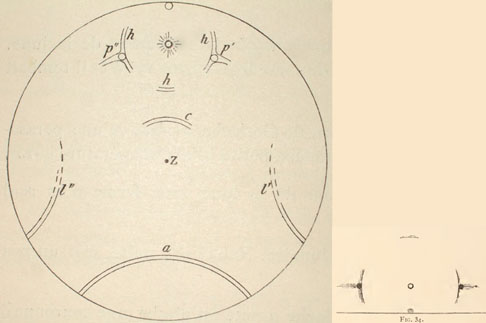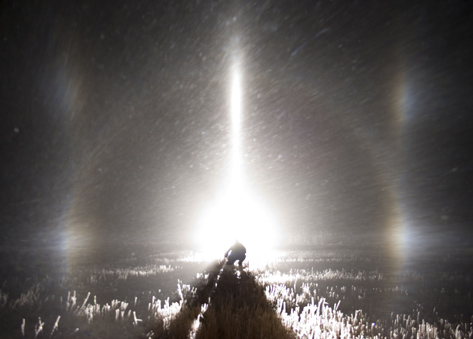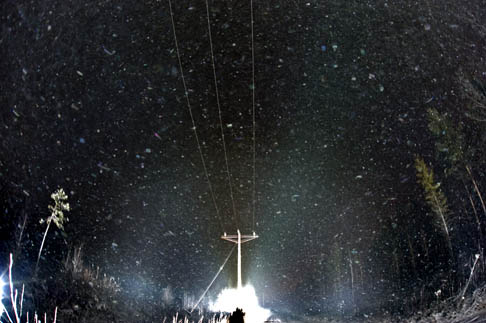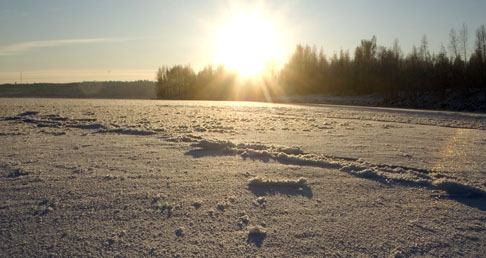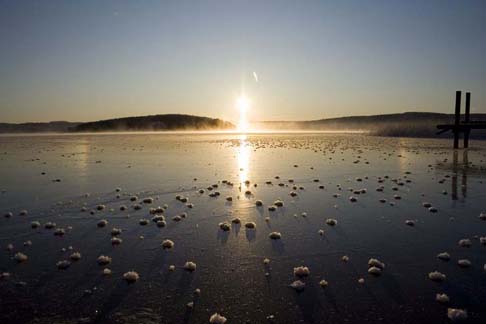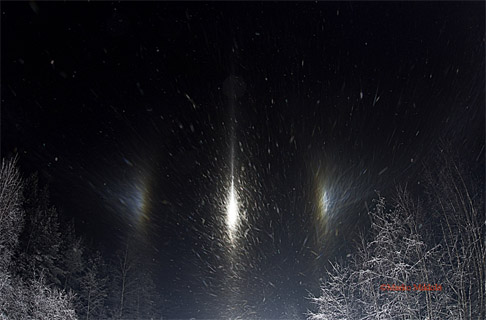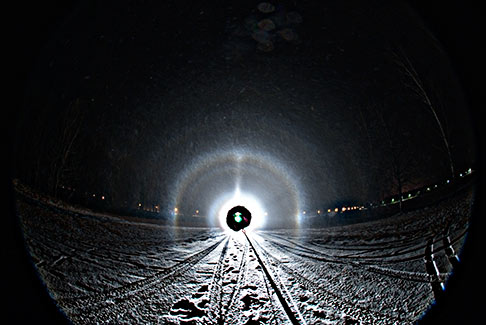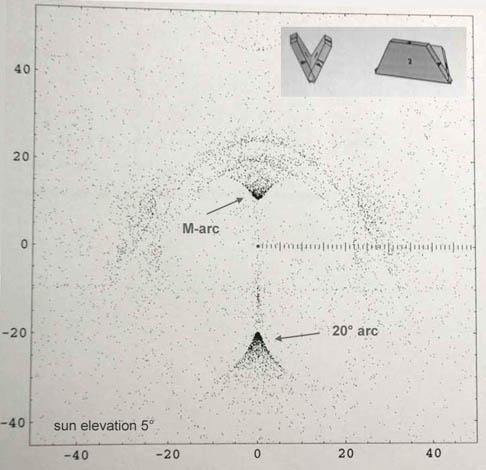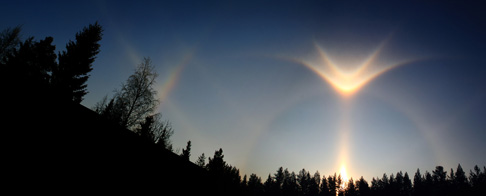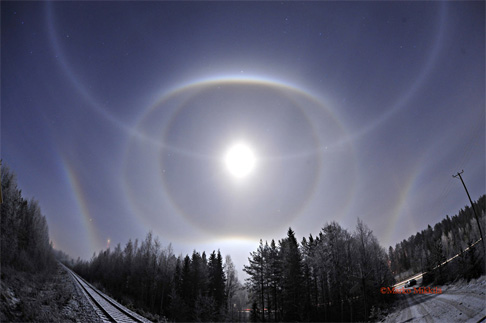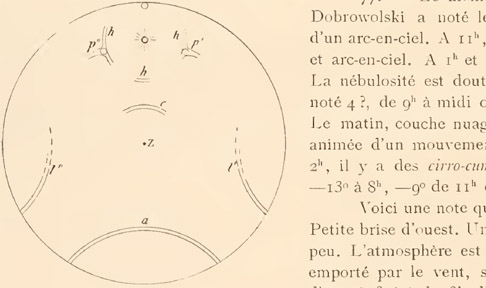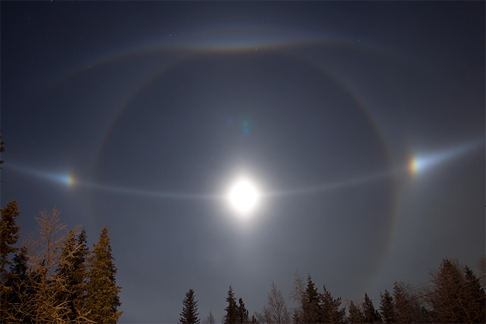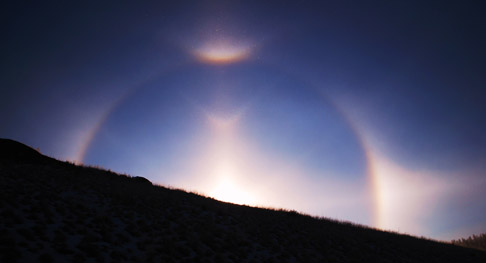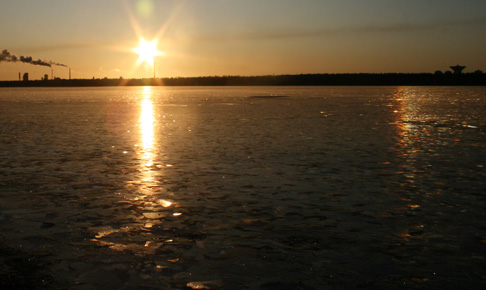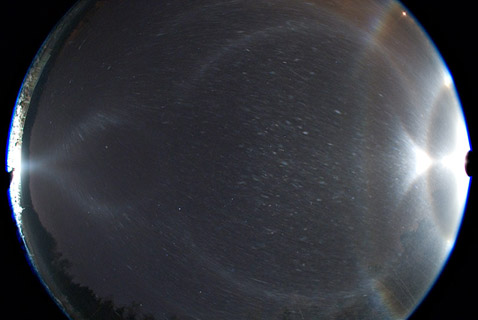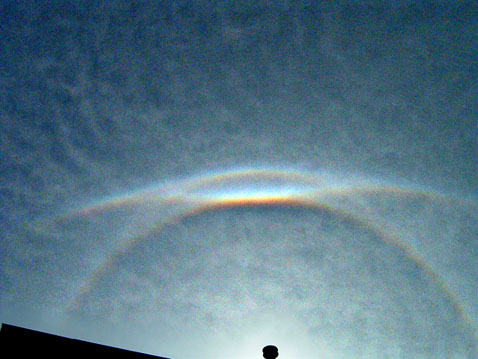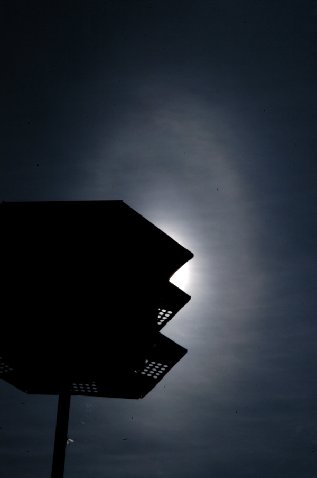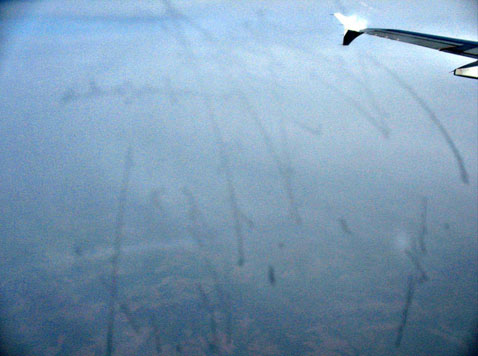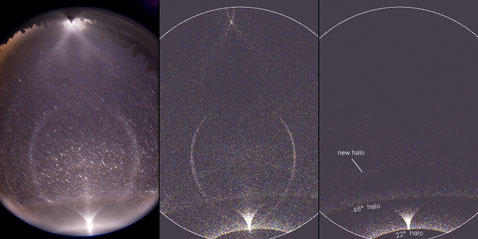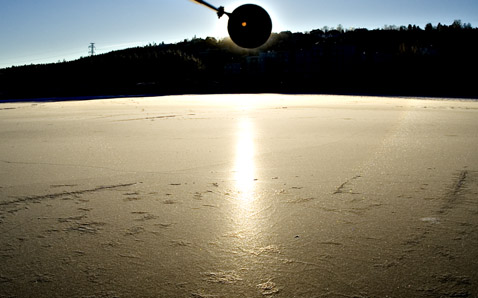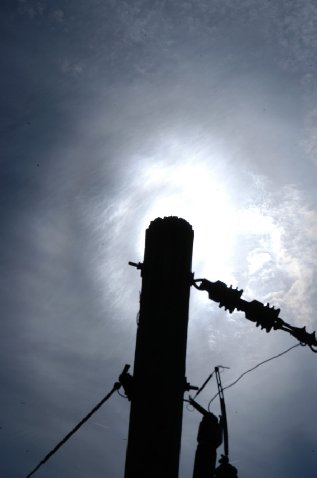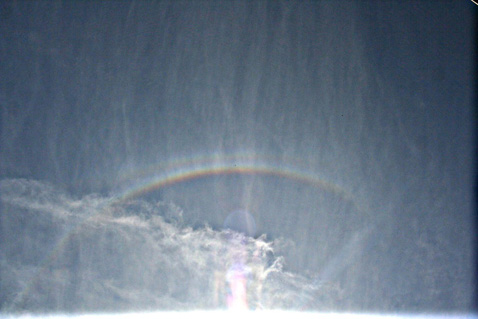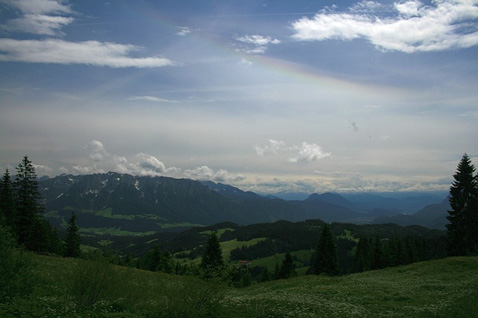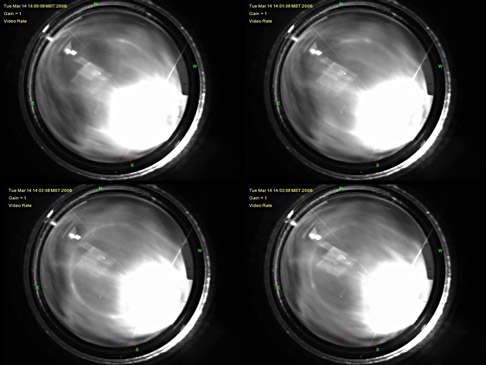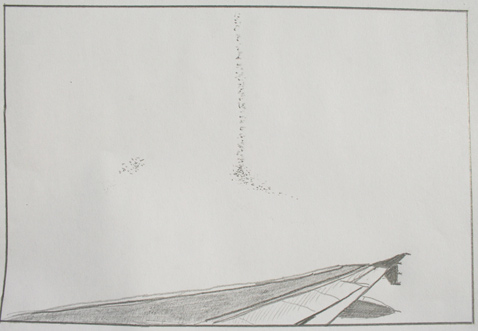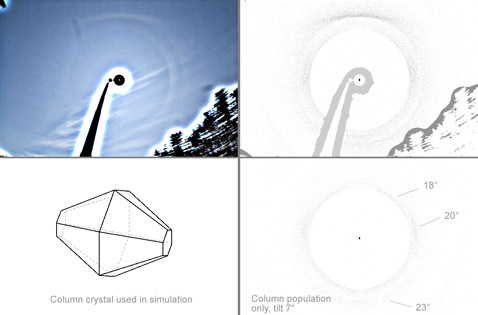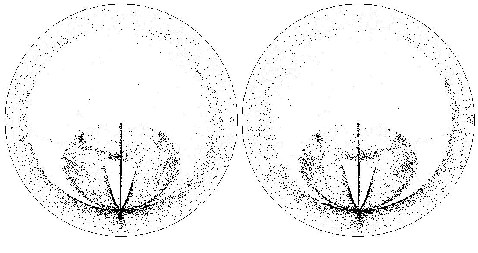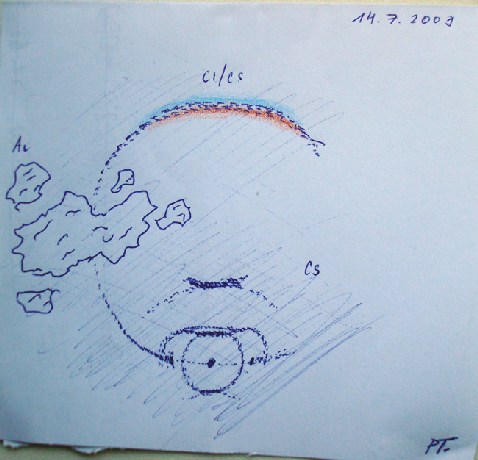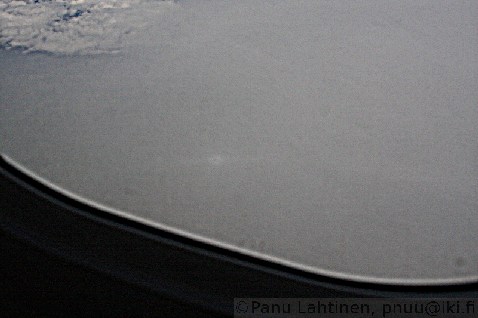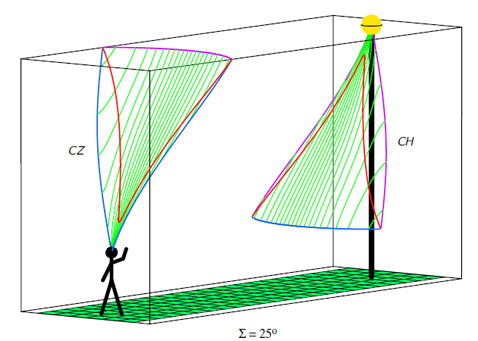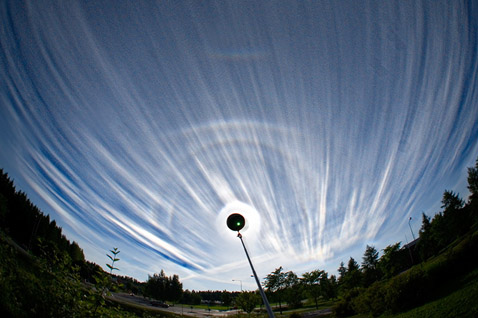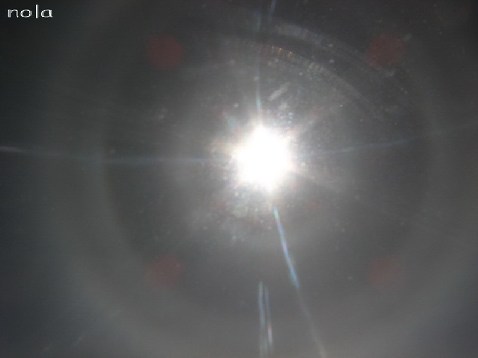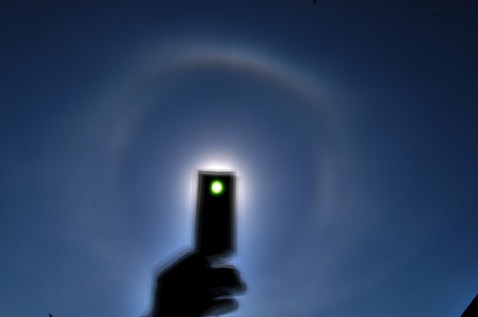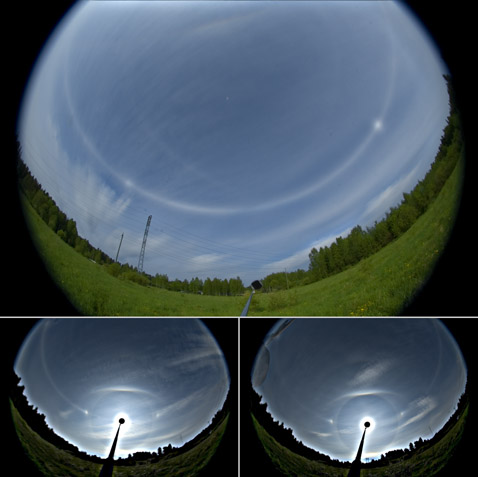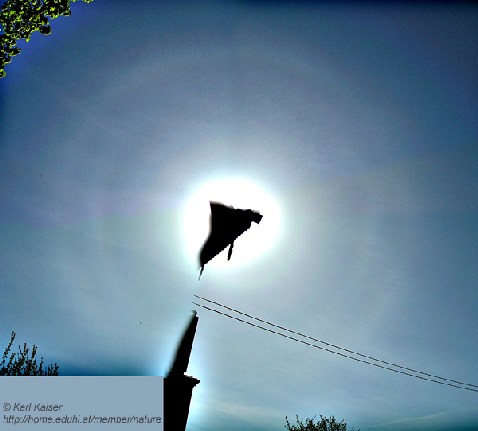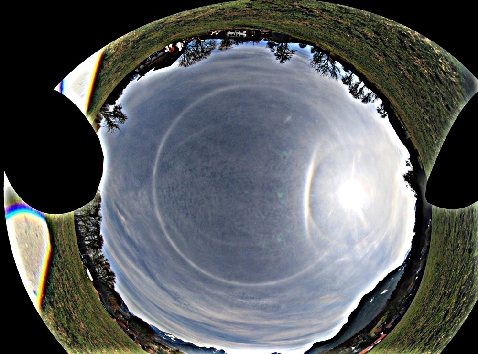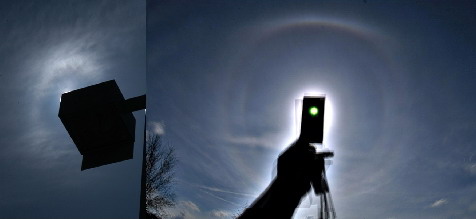2009. december 30., szerda
Halo Season in the Czech Republic
The halo season has started in the Czech Republic, too. The above image was shot by Jiri Papez on 13 December in Dvoracky ski center. Nearby on Lysa hora the display was captured by the Hydronet.cz camera ( 1 ).
2009. december 27., vasárnap
Sunvex Parry
This display was photographed on 4th December by Liisa Eronen in Kulho, Kontiolahti, Finland. The temperature was around -4°C. Nearest ski center is located about 10 km away, so most likely this was caused by snow guns.
2009. december 24., csütörtök
Moilanen arc display crystal sampled
On the 14th November Mika Aho, Ágnes Kiricsi and I were hunting halos around Himos ski resort. Diamond dust was all over the place but it was not good, offering at best less than mediocre displays. At one stage when Moilanen arc was visible, I sampled crystals while Mika and Ágnes photographed the halos. The display was pretty stable during the time the petri dish was out, so the crystal photos should be representative. See more photos of the display ( 1 ) and crystals ( 2 ). An earlier stage without Moilanen arc ( 3 ) was also crystal sampled ( 4 ).
Marko Riikonen
Marko Riikonen
2009. december 21., hétfő
Arctowski's account of the August 20, 1898 display
Below is the promised translation of the Arctowski's famous observation in the Antarctic. Thanks for Frank Le Blancq for translating. In hard brackets are some clarifications by Frank. Translation of the whole double page of the book ( 1 ) where the observation appears is also available ( 2 ).
"77 – The same day from 8 to 10am, Dobrowolski noted the parhelia, accompanied at 10am by a rainbow. At 11am he noted a halo. At midday : halo and rainbow. At 1pm and at 2pm : double halo. There was doubt about the cloud cover; thus at 8am we noted 4?, from 9am to midday 0?, at 1pm : 1?. Horizon misty. The morning a thin layer of low cloud, cirriform, moving quickly. In the afternoon at 1pm and 2pm the were some cirro-cumulus on the horizon. Temperature –13° at 8am, -9° from 11am to 2pm.
Here is a note I took at 1130am : Light westerly breeze. A little blowing snow but not much. The atmosphere was full of crystals, which, carried by the wind, scintillated [sparkled] in the air giving the impression of an infinity of gold and silver threads. We found ourselves in cirrus ; we saw it better towards the horizon, where there was a clearer aspect of mist. The halo phenomenon showed itself in a more complete form than usual. In figure 33 the outer circle represents the horizon, s the sun, z the zenith, h, h, h the fragments of the halo wth parhelia, p’, p’’ the fragments of the horizontal circle, a a rainbow as opposed to the halo, l’ and l’’ two fragments of the barely visible great arcs and finally c the arc of a circumzenithal circle. I measured the diametre of the halo h : 53° (radius 26° ; it is not therefore the normal halo). Distance from c to the zenith : 28 or 29°. The rainbow a covered 67° of the horizon and the base of the arcs l’ and l’’ we found about 30° from the extremities of arc a. The parhelia were clearly marked [visible], the same as the image of the sun on the horizon which was very bright (figure 34). There was no cross nor aureole. The fragments of the horizontal circle were like the fading lateral trails from the parhelia. The fragment of the zenithal circle (reddish, becoming white on the inside) were very interesting for the observer. We saw effectively that there were clouds of crystals [i.e many crystals] blown by the wind. It became apparent a short distance aloft of the BELGICA, because we could clearly see the gusts of crystals which passed it. Moreover, against the ships crow’s nest [lookout point up the mast] the wind produced a swirl and there it formed a little whirlwind which had a coloured appearance and which, like the circumzenithal circle, produced a bright trail. So, these phenomena far from being moved away from the observer, projected themselves as if they were a long way in the sky, while in reality they were very close to us. At about 2.30pm there were again traces of the morning parhelia and, as the atmosphere contained fewer crystals, the solar halo was very beautiful due to its variety of colours : the red inside, then orange, then yellow, the green and blue were visible. However, the coloured band was very tight [close together]."
"77 – The same day from 8 to 10am, Dobrowolski noted the parhelia, accompanied at 10am by a rainbow. At 11am he noted a halo. At midday : halo and rainbow. At 1pm and at 2pm : double halo. There was doubt about the cloud cover; thus at 8am we noted 4?, from 9am to midday 0?, at 1pm : 1?. Horizon misty. The morning a thin layer of low cloud, cirriform, moving quickly. In the afternoon at 1pm and 2pm the were some cirro-cumulus on the horizon. Temperature –13° at 8am, -9° from 11am to 2pm.
Here is a note I took at 1130am : Light westerly breeze. A little blowing snow but not much. The atmosphere was full of crystals, which, carried by the wind, scintillated [sparkled] in the air giving the impression of an infinity of gold and silver threads. We found ourselves in cirrus ; we saw it better towards the horizon, where there was a clearer aspect of mist. The halo phenomenon showed itself in a more complete form than usual. In figure 33 the outer circle represents the horizon, s the sun, z the zenith, h, h, h the fragments of the halo wth parhelia, p’, p’’ the fragments of the horizontal circle, a a rainbow as opposed to the halo, l’ and l’’ two fragments of the barely visible great arcs and finally c the arc of a circumzenithal circle. I measured the diametre of the halo h : 53° (radius 26° ; it is not therefore the normal halo). Distance from c to the zenith : 28 or 29°. The rainbow a covered 67° of the horizon and the base of the arcs l’ and l’’ we found about 30° from the extremities of arc a. The parhelia were clearly marked [visible], the same as the image of the sun on the horizon which was very bright (figure 34). There was no cross nor aureole. The fragments of the horizontal circle were like the fading lateral trails from the parhelia. The fragment of the zenithal circle (reddish, becoming white on the inside) were very interesting for the observer. We saw effectively that there were clouds of crystals [i.e many crystals] blown by the wind. It became apparent a short distance aloft of the BELGICA, because we could clearly see the gusts of crystals which passed it. Moreover, against the ships crow’s nest [lookout point up the mast] the wind produced a swirl and there it formed a little whirlwind which had a coloured appearance and which, like the circumzenithal circle, produced a bright trail. So, these phenomena far from being moved away from the observer, projected themselves as if they were a long way in the sky, while in reality they were very close to us. At about 2.30pm there were again traces of the morning parhelia and, as the atmosphere contained fewer crystals, the solar halo was very beautiful due to its variety of colours : the red inside, then orange, then yellow, the green and blue were visible. However, the coloured band was very tight [close together]."
2009. december 20., vasárnap
Subparhelia at Himos
Diamond dust started falling around Himos, Finland on 14 December, and kept on for 4 consecutive days. This display with subparhelia was shot on the first day. A full parhelic circle was also observed, and for a short time, part of the subparhelic circle was visible, too ( 1 ). Marko Riikonen sampled the crystals during the display ( 2 ).
Ágnes Kiricsi
2009. december 18., péntek
Liljequist parhelia in spotlight beam
One would think that such a demanding halo as Liljequist parhelia would need the best possible swarm to be seen. While that may be true in halo displays from natural light sources, with spotlight it is a different story. Here Liljequist parhelia - the two diffuse light areas both sides of the observers shadow - are visible despite the apparently crappy crystals that are filling the air.
Also visible are vague upwards curving extesions from Liljequist parhelia, which might have formed a complete half circle around subanthelic point if there was no cutting shadow. These are signs of the diffuse subanthelic halo that was photographed last winter in Rovaniemi ( 1 ). See also the lamp side of the display ( 2 ). The photo was taken by Marko Mikkilä in Sotkamo on 14th December. Click on the image to see a simulation.
Also visible are vague upwards curving extesions from Liljequist parhelia, which might have formed a complete half circle around subanthelic point if there was no cutting shadow. These are signs of the diffuse subanthelic halo that was photographed last winter in Rovaniemi ( 1 ). See also the lamp side of the display ( 2 ). The photo was taken by Marko Mikkilä in Sotkamo on 14th December. Click on the image to see a simulation.
One sided 22° halo on hardened snow
Last winter I noticed one sided 22° halo on ice surface ( 1 ). This winter there has been a couple of more cases with varying degree of one-sidedness. The displays seem to be a rule on even surfaces, either on plain ice or snow that wind has swept hard. The one above was seen today on lake Näsijärvi ice. It was visible on a patch of hardened snow. No matter where I moved, the asymmetry stuck.
Marko Riikonen
Marko Riikonen
2009. december 17., csütörtök
Subparhelia on ice from fallen crystals
Last Tuesday we were hunting diamond dust halos with Ágnes Kiricsi at Himos ski resort. Driving around took us to lake Päijänne, which had just started freezing. The ice was full of ice ferns, but one spot was quite clean and there subparhelia were seen. The ice surface was covered with fine powder that was wiped away from slightest disturbance. The powder was crystals that had fallen from the sky and it made the halo. Earlier we have seen examples of ice surface halos that were made of crystals grown from the lake ice ( 1 - 2 ). The image above was taken by Ágnes, see also two more of her images ( 3 - 4 ) and some of mine ( 5 ).
Marko Riikonen
Marko Riikonen
2009. december 16., szerda
Low lamp subparhelia
With the great lunar halo display from the beginning of the month still fresh in memory, Marko Mikkilä drove again to Sotkamo last monday. This time the catch was less spectacular, but something was nevertheless seen in the spotlight beam. Mikkilä managed place the lamp to a record negative angle of about -30° and photographed subsun and subparhelia as shown above. Click on the image to see more photos and also two videos.
2009. december 15., kedd
Odd Radius Halos in Diamond Dust
Spotlight beam revealed a bunch of pyramidal crystal halos on 14th December 2009 at Janakkala, Finland. I drove to Kalpalinna ski resort, where snow guns were turned on. Immediately after walking into the spotlight beam I noticed a halo well inside the 22° ring. Initially I thought that surely this is a slice of the Minnaert cigar ( 1 ), but the ring just stayed there and the crystal swarm seemed homogeneous, so I concluded that this is the 9° halo.
At the camera's LCD display the 18°/20° (?) and 35° halos could easily be seen. After first seeing them in the photo I thought I was able to see them visually too, but that was not certain. I did mess up the crystal sample, since the most-likely-pyramidal-crystals are distorted and round - the gear was still too warm during the sampling. On the other hand, if I would have waited longer, there would not be any signs of pyramids in crystal samples, since the pyramidal phase was gone in less than 10 minutes and did not reoccur during the rest of the night.
By clicking the image above the gallery opens.
At the camera's LCD display the 18°/20° (?) and 35° halos could easily be seen. After first seeing them in the photo I thought I was able to see them visually too, but that was not certain. I did mess up the crystal sample, since the most-likely-pyramidal-crystals are distorted and round - the gear was still too warm during the sampling. On the other hand, if I would have waited longer, there would not be any signs of pyramids in crystal samples, since the pyramidal phase was gone in less than 10 minutes and did not reoccur during the rest of the night.
By clicking the image above the gallery opens.
2009. december 8., kedd
When you see Moilanen arc - look below the sun!
Several of us have been talking about a possible explanation for M-arcs. The responsible crystals are twinned trapezoidal plates that have what might be called restricted Lowitz orientations. The crystals perform rotational oscillations about a horizontal axis, with the equilibrium orientation having the vee opening directly upward, as in the left hand crystal.
All of us are more or less skeptical about this explanation, but we think it deserves testing. The model predicts a strong lower 20° arc. We are asking that, if you are lucky enough to see an M-arc, then please put yourself in an elevated position and look for the lower 20° arc. There are other observing suggestions as well, but I think I will leave them for the blog.
(Walt Tape)
All of us are more or less skeptical about this explanation, but we think it deserves testing. The model predicts a strong lower 20° arc. We are asking that, if you are lucky enough to see an M-arc, then please put yourself in an elevated position and look for the lower 20° arc. There are other observing suggestions as well, but I think I will leave them for the blog.
(Walt Tape)
2009. december 7., hétfő
Bright sunvex Parry arc
Sometimes halo display actually comes to your door step. On October 14th Toivo Säkkinen got out of his house in Kuusamo to feed the birds. Instead, he decided to photograph the halos first. This must be one of the earliest diamond dusts in Finland.
2009. december 5., szombat
Lunar halo complex in Sotkamo, Finland
In the morning of 3rd Decemeber Marko Mikkilä packed his halo gear and drove 200 kilometers to Sotkamo, where snow guns were running at the local ski resort. Once he arrived, there was fog, but it was mainly water fog and only occasional poor halos were seen.
However, when darkness fell, the water fog cleared off and diamond dust started kicking in as the air got colder. In the beginning the moon showed no good halos but spotlight gave a reasonable display ( 1 ). Later also the moon halos catched on, as is seen above. Click on the image for more photos.
Simulation of the display ( 2 ) needed slightly flattened columns to get the subhelic arc intensity right. With any other crystal shapes, the part opposite to the moon where this halo is tangent to Tricker arc, was not visible. Intuitively those flattened crystals would take Parry orientation, so it looks like again we are not really understading it. Same effect was also present in the great Himos display last winter ( 3 ).
After midnight Mikkilä headed home because the high clouds in the background were becoming too disturbing. All together the halo hunting trip took 600-700 km of driving. Looking at the results it was definitely worth it. See also the photos by Jari Luomanen from the same night at the Sappee ski resort, and be sure to read his insightful description of the diamond dust formation on the right ( 4 ).
However, when darkness fell, the water fog cleared off and diamond dust started kicking in as the air got colder. In the beginning the moon showed no good halos but spotlight gave a reasonable display ( 1 ). Later also the moon halos catched on, as is seen above. Click on the image for more photos.
Simulation of the display ( 2 ) needed slightly flattened columns to get the subhelic arc intensity right. With any other crystal shapes, the part opposite to the moon where this halo is tangent to Tricker arc, was not visible. Intuitively those flattened crystals would take Parry orientation, so it looks like again we are not really understading it. Same effect was also present in the great Himos display last winter ( 3 ).
After midnight Mikkilä headed home because the high clouds in the background were becoming too disturbing. All together the halo hunting trip took 600-700 km of driving. Looking at the results it was definitely worth it. See also the photos by Jari Luomanen from the same night at the Sappee ski resort, and be sure to read his insightful description of the diamond dust formation on the right ( 4 ).
2009. december 3., csütörtök
Halo display in Himos on the evening of 2nd Dec 2009
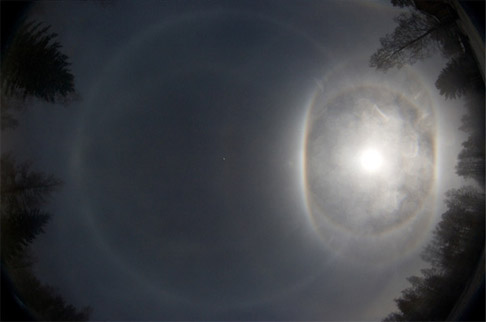
Arctowski's book of optical phenomena in the Antarctic
In 10 March 1897, a scientific research expedition ship Belgica got stuck in ice in the Antarctic waters. On board the ship was a Polish scientist Henryk Arctowski, who made notes of optical phenomena during the ship's one year and 3500 kilometer drift with the ice. His book of these observations, "Phenomenes Optiques de l'atmosphere", is now online ( 1 ).
Shown above is his most well known halo observation, the one with the "Arctowski arcs" that in the drawing rise from the horizon at about 120° from the sun. There are also other peculiarities, for Arctowski reports the patches of h to be 26 - not 22 - degree radius from the sun and the circumzenith arc distance from the zenith to be 28-29 degrees, which is probably more than it should be at the observation's sun elevation.
But if we leave the measurements aside and look at the drawing, the sunside of the sky looks pretty ordinary. The Arctowski arcs, which he writes as being faint, could be misplaced 46° infralateral arcs. And the rainbow in the opposite sky could be a fogbow. So, nothing extraordinary there, except maybe for the fogbow, that still has not been captured on film with halos in naturally lighted conditions.
Any French speaking readers here who could translate Arctowski's account of the display (PDF page 40-41)? It looks like he had made some interesting notes on the halos showing up in nearby crystals. I can add it here.
Shown above is his most well known halo observation, the one with the "Arctowski arcs" that in the drawing rise from the horizon at about 120° from the sun. There are also other peculiarities, for Arctowski reports the patches of h to be 26 - not 22 - degree radius from the sun and the circumzenith arc distance from the zenith to be 28-29 degrees, which is probably more than it should be at the observation's sun elevation.
But if we leave the measurements aside and look at the drawing, the sunside of the sky looks pretty ordinary. The Arctowski arcs, which he writes as being faint, could be misplaced 46° infralateral arcs. And the rainbow in the opposite sky could be a fogbow. So, nothing extraordinary there, except maybe for the fogbow, that still has not been captured on film with halos in naturally lighted conditions.
Any French speaking readers here who could translate Arctowski's account of the display (PDF page 40-41)? It looks like he had made some interesting notes on the halos showing up in nearby crystals. I can add it here.
2009. november 30., hétfő
Moon diamond dust halos in Lappland
This splendid display was seen last night in Sirkka, Finland. The photographer, Timo Veijalainen, tells the display lasted for about an hour after he noticed it and that the temperature was close to -10° C. Sirkka is a settlement right next to Levi ski center, from which snow guns this must have originated. Click above to see more images on the photographer's site and check also what Les Cowley says about the halos ( 1 ).
2009. november 25., szerda
46° contact arc
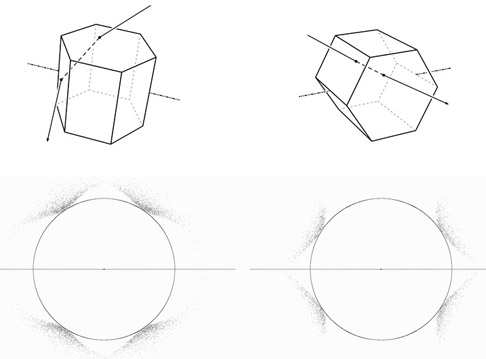
46° contact arc is formed by Lowitz-oriented crystals and it divides in three components. One of the components comes from raypaths that pass through prism face that is parallel to the Lowitz axis. This component is found straight above and below the sun. In spinning crystals light ray can enter both prism and basal face (1-3 / 3-1 type).
Two other components (shown above for 0° sun elevation) are formed by raypaths that pass through prism face that is at an oblique angle to the Lowitz axis. They are distinguished by the ray either entering (4-1 type) or exiting (1-4 type) this face. These arcs are not in the solar vertical and their position changes with sun elevation.
See simulations (Jukka Ruoskanen's software) where 46° contact arc components are shown from spinning crystals for different sun elevations ( 3 - 4 ). Normally, though, halos from Lowitz orientation are not indicating spinning-type orientation distribution. Rather, we will see 46° contact arc from either plate-Lowitz or Parry-Lowitz orientation ( 5 ).
On most sun elevations 46° contact arc components conform deceptively the curvature of the 46° halo. Circumzenith arc also can overlap upper components. Because of the delicate form of 46° contact arc, it may be very difficult to observe in high clouds. Chances are certainly better in uniform diamond dust.
2009. november 24., kedd
Sharp Moilanen arc
2009. november 22., vasárnap
Subparhelia on ice surface
Circular halos on snow surface are common sights, but on ice surface halos are seen much less often. When ice surface halos do show up, they are made by oriented crystals and can be rather bright. Such was the case this morning in Oulu, Finland, where subparhelia was photographed by Karin Parker on lake Pyykösjärvi ( 1 ).
Once in similar situation also sub-120° parhelion and subanthelion was seen ( 2 ). If ice is thick enough, it is good take a little walk and and look around for these less conspicuous halos as well.
Once in similar situation also sub-120° parhelion and subanthelion was seen ( 2 ). If ice is thick enough, it is good take a little walk and and look around for these less conspicuous halos as well.
2009. november 20., péntek
Helic arc in high clouds
Helic arc is no news in snow gun generated diamond dust displays, but in high clouds the halo is extremely rare. Of the latter type, shown here is the latest case. The display was seen in Alpharetta, Georgia, U.S.A, in 5 December 2008 and the photo was taken by Thomas Faber. Click on the image to read Les Cowley's notes on the display. There is also a simulation included.
2009. november 17., kedd
First spotlight display
Winter's first display in a spotlight beam was captured in the weekend by Jukka Ruoskanen. Click on the image to see the rest of his photos.
2009. november 16., hétfő
Moilanen arc without Parry or tangent arc
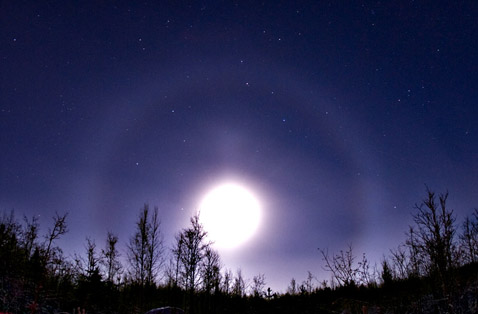
The photo was taken by Marko Mikkilä on 15 January 2009 in Sievi.
2009. november 15., vasárnap
Moilanen arc without plate arcs
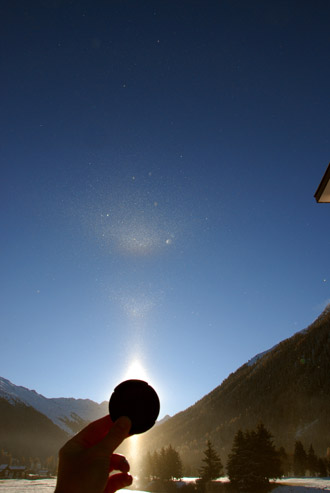
Thus, the crystal wedge angle that makes the Moilanen arc does not seem to occur in plate crystals. Column oriented crystals seem to also be out of question, because in simulations for one thing this orientation would make also lower Moilanen arc, which has not been observed yet. And if we assume that some of the columns or plates take Parry orientation, it makes sense to conclude that Parry crystals are neither the answer.
So, it feels like Moilanen arc crystal makes no other halos at all, and finding the crystals from crystal samples should be easy. But we have looked at many samples already and there has never been anything peculiar occuring in great enought numbers to name as a suspect. It is also interesting that Moilanen arc has not been seen alone yet, which could imply that its crystal after all makes other halos.
It is mysterious, but one day somebody is bound to take those desicive photos. Displays that have common halos only from one crystal orientation (such as here) are of course the best ones to look for the crystal.
2009. november 12., csütörtök
Upper Lowitz arc
Glenn Wolford photographed this display on November 9 in Syracuse, N.Y., U.S.A. The noteworthy feature is the upper Lowitz arc from Parry-Lowitz orientation. Click on the photo for simulation. Lowitz crystal tilts in the simulation are 13 degrees and sun elevation 30 degrees. Simulations and crystal figures from Jukka Ruoskanen's software. See also another photo ( 1 ).
2009. október 20., kedd
4th Elliptical halo!! Yeah baby woot woot woot!!!
While staying with relatives down in Bedford Indiana, one morning before we left to French Lick Casino I saw a large field of AC clouds slowly moving out of the area and I know AC clouds means elliptical halos. I looked up and saw the trailing edge of the clouds nearing the sun and I noticed they were forming virga sheets and as it drew nearer I took the gamble to watch. As the sun came into view I saw a diffuse sunpillar form and it later on got more defined and I watched as a small crescent of light formed in the pillar and it coalesed into an elliptical halo! Throughout the duration I could only see one ellipse and it was quite bright and well defined. I only need two more to tie Mika Sillanpaa's record. Look out Mika I need two more observations to tie your record and who knows I could beat it. I will gamble with halos not at slot machines at least I won't loose money with halos. ( 1 ).
Text: Michael Ellestad
Text: Michael Ellestad
2009. október 19., hétfő
Sub-120° parhelion photographed
Starting from the 1970's we have seen numerous photos of subparhelic circle opposite to the sun and it is a little wonder that sub-120° parhelion has never been observed from an airplane. Even the sub-Liljequist parhelion, of which formation is sensitive to crystal shape deviations from regular hexagon, and which from that point of view should be rarer than sub-120° parhelion, has been photographed a couple of times.
Well, given enough time, things are bound to change. On 31 July this year sub-120° parhelion was finally photographed. The man behind the camera, Tomas Trzicky, was on a return trip from watching a total sun eclipse in China. The halo display appeared on the last stretch of this trip, on its last hour, when the airplane started descending to Prague.
"I was really lucky - actually I was sitting in the isle during most of the flight, one member of our observing group left her window seat for a while, so I more or less routinely checked the white haze outside - and there it was :-)", tells Tomas.
The sub-120° parhelion was captured on two photos, click on the image above to see them. To the left from the halo is a patch of subparhelic circle, which most probably is sub-Liljequist parhelion. Further left, in other photos, subanthelion and faint diffuse anthelic arcs crossing it are also visible ( 1 ). The window was dirty and it was frosty, but it just adds to the magic of discovery.
These photos may explain why sub-120° parhelion has not been captured earlier. It occurs as an isolated white spot, without subparhelic circle crossing it. Unless being exceedingly bright, it must be easily missed. Most certainly sub-120° parhelion has occurred in all of the displays with subparhelic circle, because plates are the major contributor to subparhelic circle intensity. Subparhelic circle made solely by Parry orientation is more of a theoretical consideration, and columns do not make subparhelic circle at all.
Sub-120° parhelion has been photographed once earlier in spotlight beam in diamond dust ( 2 ), but Tomas's "old school" observation is of course the true discovery. See also Les Cowley's report ( 3 ) on the case.
2009. október 18., vasárnap
New halo from spotlight beam
It's been before our noses for a year already ( 1 ): the weak colored arc reaching far outside the 46° halo in the display observed on the night of 5/6 November 2008 in Rovaniemi. I have thought of it as some sort of 46° supralateral arc extension below the horizon. But something has not felt quite right with that and I finally decided to run a simulation.
The halo arises in column crystals from 3-5-1 and 3-6-1 raypaths ( 2 ). Thus it is not 46° supralateral arc. Rather, these raypaths make it a reflection of 46° supralateral arc. If circumnadir arc had been visible in the display, this halo would have been tangent to it ( 3 ) similarly as normal 46° supralateral arc is tangent to circumzenith arc.
The simulation above was made with column and random oriented crystals. Crystals towards triangular shape seemed to provide best overall fit with the photo. Light source elevation for the simulation was -11.5 degrees. The simulation on the right is filtered, showing some common halos together with the new halo arc.
What should we call this? Reflected (46°) supralateral arc or sub(-46°) supralateral arc? If we were to choose the former, the "Ounasvaara arc" ( 4 ) which arises from similar raypath (8-4-1) in Parry crystals, could be then called reflected (46°) Parry supralateral arc.
Simulations and crystal raypath figures are from Jukka Ruoskanen's software.
Blue circle and blue spot
These simulations show the relation of blue circle (from random crystals) and blue spot (from oriented crystals). Blue spot on parhelic circle occurs where blue circle crosses it. The blue circle itself has a radius of 64°, as Ágnes Kiricsi has pointed out, and it is centered around the subanthelic point. Sun elevations in the simulations are 10°, 20° and 31°. When sun is higher than 32°, blue spot is no more seen. Simulations are made with Jukka Ruoskanen's software.
2009. október 8., csütörtök
Asymmetric intensity of 22° halo on ice surface
This 22° halo on ice surface was seen on 17 January in Tampere. It was more pronounced on the right side. Intensity asymmetry was not caused by local changes in crystal densities because it was seen wherever I walked on the ice.
The effect must be made by atsimuthally oriented crystals on the lake ice. Possibly wind blowing from one direction had caused non-uniform deposition of moisture, resulting in (poorly) atsimuthally locked crystals.
See animation ( 1 ), which involves about 70 photos taken during 30 meters camera movement. The asymmetry effect is also seen in stacked image of 117 frames ( 2 )
This is not the first time when asymmetry of halos on ice surface has been noticed. In December 2007 Jari Piikki photographed curiously inclined halos in Juva ( 3 ).
2009. október 5., hétfő
Elliptical halos from the US
On 1 October I got two elliptical halos and you can see them here. I would have gotten more pics but I was busy helping my mother get the house ready for the fall harvest party. I wish I could have seen the halos from the start but when I first saw it the halos were in progress. This will count as my third elliptical halo observation this year ( 1 ).
Text: Michael Ellestad
Text: Michael Ellestad
2009. szeptember 4., péntek
Highest sun Parry of Germany
On 26 July 2009, at a sun elevation of 60.1°, I observed a second arc above the 22° halo and complete circumscribed halo ( 1 ). Besides it, there was also a CHA, and later a parhelic circle appeared. Further haloes were not present. At this sun elevation the Parry arc and the 23° plate arc are in similarly position, a precise distinction is very difficult, particularly that other observers reported further Parry arcs and other pyramidal haloes (9° and 18° halo), too. As the complete form of the arc can more or less be seen in the usm-ed image, I tend to Parry arc. This would actually be the Parry arc at highest sun elevation in the German 24-year statistic. ( 2 - 3 - 4 )
Text: Claudia Hinz
Text: Claudia Hinz
2009. szeptember 3., csütörtök
Infralateral arc at high sun elevation
Not everything that is apparently a circumhorizontal arc is really one. I saw this halo on 8 July 2009 on Mount Spitzstein (1596m) at the German-Austrian Border. Besides a complete circumscribed halo, a reddish brightening appeared in the CHA-area. I was very delighted to see my first CHA this year, but the arc became longer and rounder ( 1 ). It was obvious that the arc was not parallel to the horizon. Therefore it had to be an infralateral arc. The sun elevation was 60.6°. ( 2 - 3 )
Text: Claudia Hinz
Text: Claudia Hinz
2009. augusztus 28., péntek
Halos on MMTO Sky Camera
MMT Observatory in Arizona has an automatic all sky camera that records the sky day and night. Archived videos are available from 2006 ( 1 ). Halos are visible in these recordings (although many displays are lost to the overexposure). Here are some examples:
- 22° halo / circumscribed halo. In the beginning possibly 9° halo ( 2 )
- Parhelion and patches of parhelic circle starting at 15:46 ( 3 )
- Parhelic circle starting at 13:58. Also 120° parhelion appears. The image above shows 60 seconds stacks of the display ( 4 )
- Parhelic circle appears at 21:15 ( 5 )
- 22° halo and some upper tangent arc, best starting at 02:00 ( 6 )
Ágnes Kiricsi, Marko Mikkilä and Mónika Landy-Gyebnár went through several months of the recordings listing the ones with halos ( 7 - 8 - 9 ). In ( 7 ) the best displays are pasted orange. Much of the MMTO Sky Camera material is still unchecked with regard to halos, certainly there are some decent displays to be found.
2009. augusztus 27., csütörtök
Time lapse halo clips from Thailand
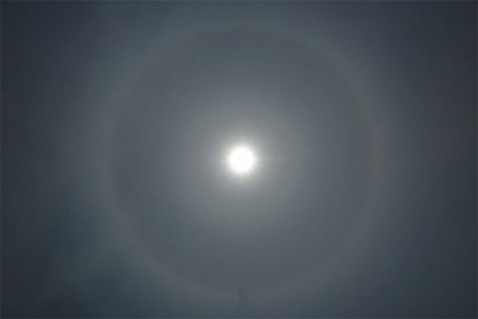
An avid atmospheric optics photographer, Pitan Singhasaneh has recently started experimenting with time lapse halo photography. Even though the displays are not special, the cloud movement and changes in halos create its own kind of magic. Pitan's videos are available at his Time-lapsed Photogaphy site ( 1 ). The photo above is from one of these displays, showing a 9° halo. If you like to see how halos in general look in the tropical climate of Thailand, see Pitan's photos from 2008 and 2009 ( 2 - 3 ).
2009. augusztus 25., kedd
Riddle
On 8 August, I was flying from Barcelona to Hungary, when I saw a faint pillar of ice crystals glistening close to me outside the window, at right angle to it. The pillar was white and the crystals were so near that I could see them individually. The sun was behind the plane at 54 degs elevation. The display lasted two or three minutes. Ideas of what it could have been are welcome.. Two original photos and their usm-ed versions are attached. Note also the other patch of glistening crystals to the left of the pillar ( 1 - 2 - 3 - 4 ).
2009. augusztus 16., vasárnap
20° column arc
This minor odd radius came with a surprise after stacking. Outside the 18° halo / plate arc there seems to be a faint, but rather well defined 20° column arc. As there is no sign of 9° stuff, crystals had no middle prism which is rather rare situation. The display was observed on August 9 in Kontiolahti.
2009. augusztus 13., csütörtök
Lars Gislén's streetlight halo simulator
The halo application simulates streetlight halos ( 1 ). It can handle plate and column crystals as well as Parry oriented crystals. It can generate stereo pictures both for viewing in a stereo viewer or directly with "crossed yes". The application can also generate a data file with the 3D location of the crystals involved in the display that can later be viewed in a separate 3D viewer.
There is a short PDF manual together with an explanation of how the halo is simulated. Finally you can download the (rather messy) Java source code.
Detailed (large recycle value) halos may take the order of one hour to simulate. With the least detailed (recycle = 1) setting it takes much shorter time.
There are two implementations of the halo applications, one for Macintosh OS X 10.4+ and one for Windows. A Windows machine may need to download the Java Runtime Environment (JRE) that is available free ( 2 )
Text: Lars Gislén
There is a short PDF manual together with an explanation of how the halo is simulated. Finally you can download the (rather messy) Java source code.
Detailed (large recycle value) halos may take the order of one hour to simulate. With the least detailed (recycle = 1) setting it takes much shorter time.
There are two implementations of the halo applications, one for Macintosh OS X 10.4+ and one for Windows. A Windows machine may need to download the Java Runtime Environment (JRE) that is available free ( 2 )
Text: Lars Gislén
2009. augusztus 12., szerda
Coloured parhelic circle
Sub-anthelion
First Panu Lahtinen thought he had seen the 120 deg sub-parhelia, but
after consulting Jarmo Moilanen, who noticed the shadow of the airplane,
the halo was identified to be "only" a sub-anthelion with a short
sub-parhelic circle attached to it. No other halos were seen. ( 1 - 2 - 3 )
The halos were seen on a flight from Helsinki to Ivalo on July 21, 2009
at 17:40 local time, and they were visible only for approximately 10-15
seconds.
after consulting Jarmo Moilanen, who noticed the shadow of the airplane,
the halo was identified to be "only" a sub-anthelion with a short
sub-parhelic circle attached to it. No other halos were seen. ( 1 - 2 - 3 )
The halos were seen on a flight from Helsinki to Ivalo on July 21, 2009
at 17:40 local time, and they were visible only for approximately 10-15
seconds.
2009. július 9., csütörtök
119 pages of streetlight halos
The days are shortening and winter is coming soon. What a better way to get pumped for the upcoming diamond dust season than reading Walt Tape's 119 page treatment on spatial halos. New effects like superparhelic circle await for their discoverers. About half of the contents is the old stuff that you may have read already, but Walt has made some changes, so it is not bad idea to go through those parts as well.
Click on the image to go Walt's page to download it.
Click on the image to go Walt's page to download it.
2009. július 1., szerda
A mid-summer multihalo in Finland
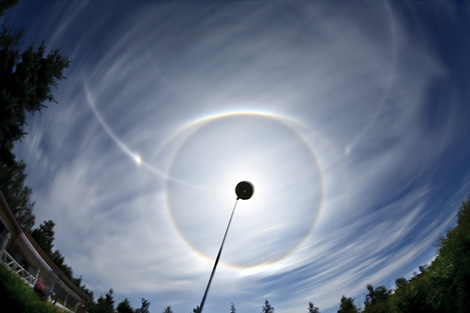
This display was observed on 1 July 2009 in Tampere, Finland. The most prominent features were the bright upper tangent arc (contributing to a partial circumscribed halo) and the parhelic circle. A faint Wegener arc can be seen rising above the upper tangent arc. The sun elevation was 46 degrees. More photos on Jari Luomanen's website (1).
Odd radius halos 30 June, Finland
Halos were observed throughout Southern Finland. Above Jukka Ruoskanen's photo, click to go his site. Photos by others:
2009. június 23., kedd
Odd radius rings from an airplane
Mónika Bodó photographed these odd radius halos on a flight from Amsterdam to Budapest on 20 June. The display lasted about 7-8 minutes and was observed during the descent to Budapest. Further photos are available in Mónika's album ( 1 ).
2009. június 19., péntek
2009. június 12., péntek
Short lived all sky display in Joensuu
This display was on when I woke up. It did not last long and was also plagued with lower clouds. I did not have mirror and could not see Wegener arcs, which are present in 3 minutes stack above.
2009. május 27., szerda
Pyramid halos in Tampere, Finland
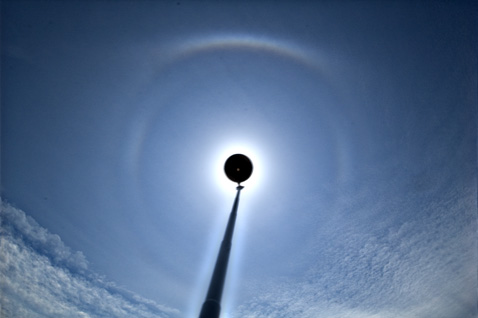
This display appeared today treacherously from behind Ac clouds. It did not last long, as Ac came to veil it again. 14 frames stack from 5 minutes.
2009. május 10., vasárnap
Odd radius halos from Austria
On 27th of April 2009 during the hours before noon an almost complete 23° ring was visible and also both 18° lateral arcs. All halos were visible without sunglasses. The cirrus was very dense. I know days when pyramidal halos were visible over a big area of Central Europe, but this day there are no other reported observations. The photo above shows the display with unsharp masking, but the original photo is also provided ( 1 ). Later this day only the upper part of the common 22° halo was visible.
Text: Karl Kaiser
Text: Karl Kaiser
2009. április 14., kedd
Wegener over a large area of Europe
On 18 March, nice halo phenomena with complete and bright parhelic circle and Wegener's anthelic arc were seen in Germany, Austria, Switzerland and France. The extent of the area where the Wegener was observed is remarkable!
Some of my own photos from Brannenburg, Southern Germany can be seen in an album or as a slide show ( 1 - 2 ). More pictures from other observers in West Germany, Austria, Switzerland and France are linked at spaceweather.com and in the German halo forum ( 3 - 4 ).
Text: Claudia Hinz
Some of my own photos from Brannenburg, Southern Germany can be seen in an album or as a slide show ( 1 - 2 ). More pictures from other observers in West Germany, Austria, Switzerland and France are linked at spaceweather.com and in the German halo forum ( 3 - 4 ).
Text: Claudia Hinz
2009. április 6., hétfő
Elliptical and odd radius halos on the same day
On the way home from work I photographed a bright elliptical halo ( 1 ). Later on as winds from a cold front pushed a lot of low level cumuliform clouds away and I was on the state route when this happened and I held my sunglasses near my car's windshield I could make out a bright arc on top of a halo and a closer look showed another halo. I pulled off on to a small road and got to watch a half decent odd radius halo. in all I got 9, 18, 20, 23, and faint 35d halos and a bright upper 23d plate arc ( 2 - 3 ).
Text: Michael Ellestad
Text: Michael Ellestad
2009. március 28., szombat
Lowitz arcs
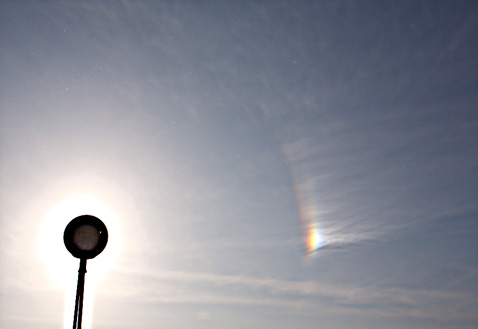
Feliratkozás:
Bejegyzések (Atom)
